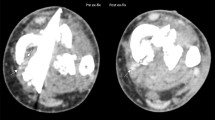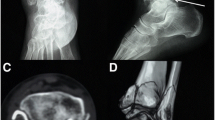Abstract
Objective
The incidence of posterior pilon variant fractures has been underestimated. The purpose was to study the characteristics of posteromedial (PM) and posterolateral (PL) fragments in CT imaging of posterior pilon variant fractures, and to provide help for clinical diagnosis and treatment.
Methods
CT imaging data of 109 cases of posterior pilon variant fractures in our hospital from January 2013 to December 2020 were retrospectively analyzed. According to Mason and Molloy classification, PM fragments were further divided into pilon subtypes and avulsed subtypes. The largest actual area of fragments in axial and sagittal were selected as the study plane, and the maximum axial lengths of X, Y and Z, α angle, β angle, fragment area (S1–7) and fragment area ratio (FAR1-4), interfragmentary (IF) angle, and back of tibia (BT) angle were measured.
Results
A total of 109 cases were included in this study, 61 of whom were pilon subtypes [90.16% were supination-external rotation (SER) injuries]. 48 cases were avulsed subtypes [81.25% were pronation-external rotation (PER) injuries]. Pilon subtypes were larger than avulsed subtypes in X, Y, Z, α2 Angle, β2 Angle, fragment area and ratio, and IF and BT angle (P < 0.05). There was no difference between α1 and β1 angle (P > 0.05).
Conclusion
The morphology of pilon subtype was larger than that of avulsion subtype. According to fragment size, morphology, and injury mechanism, two fragments of pilon subtype should be anatomic reduction and fixation. However, the PL fragment of avulsion subtype should to be fixed, while PM fragment may only need conservative treatment.










Similar content being viewed by others
References
Broos PL, Bisschop AP (1991) Operative treatment of ankle fractures in adults: correlation between types of fracture and final results. Injury 22(5):403–406
Court-Brown CM, McBirnie J, Wilson G (1998) Adult ankle fractures–an increasing problem? Acta Orthop Scand 69(1):43–47
Jaskulka RA, Ittner G, Schedl R (1989) Fractures of the posterior tibial margin: their role in the prognosis of malleolar fractures. J Trauma 29(11):1565–1570
Tejwani NC, Pahk B, Egol KA (2010) Effect of posterior malleolus fracture on outcome after unstable ankle fracture. J Trauma 69(3):666–669
Gardner Michael J, Sreevathsa B, Hentel Keith D et al (2007) The hyperplantarflexion ankle fracture variant. J Foot Ankle Surg 46(4):256–260
Weber M (2004) Trimalleolar fractures with impaction of the posteromedial tibial plafond: implications for talar stability. Foot Ankle Int 25(10):716–727
Switaj PJ, Weatherford B, Fuchs D et al (2014) Evaluation of posterior malleolar fractures and the posterior pilon variant in operatively treated ankle fractures. Foot Ankle Int 35(9):886–895
Haraguchi N, Haruyama H, Toga H et al (2006) Pathoanatomy of posterior malleolar fractures of the ankle. J Bone Jt Surg Am 88(5):1085–1092
Mason LW, Marlow WJ, Widnall J et al (2017) Pathoanatomy and associated injuries of posterior malleolus fracture of the ankle. Foot Ankle Int 38(11):1229–1235
Bartonicek J, Rammelt S, Kostlivy K et al (2015) Anatomy and classification of the posterior tibial fragment in ankle fractures. Arch Orthop Trauma Surg 135(4):505–516
Büchler L, Tannast M, Bonel HM et al (2009) Reliability of radiologic assessment of the fracture anatomy at the posterior tibial plafond in malleolar fractures. J Orthop Trauma 23(3):208–212
Amorosa LF, Brown GD, Greisberg J (2010) A surgical approach to posterior pilon fractures. J Orthop Trauma 24(3):188–193
Klammer G, Kadakia AR, Joos DA et al (2013) Posterior pilon fractures: a retrospective case series and proposed classification system. Foot Ankle Int 34(2):189–199
Stufkens SA, van den Bekerom MP, Knupp M et al (2012) The diagnosis and treatment of deltoid ligament lesions in supination-external rotation ankle fractures: a review. Strateg Trauma Limb Reconstr 7(2):73–85
McDaniel WJ, Wilson FC (1977) Trimalleolar fractures of the ankle. An end result study. Clin Orthop Relat Res 122:37–45
Evers J, Fischer M, Raschke M et al (2021) Leave it or fix it? How fixation of a small posterior malleolar fragment neutralizes rotational forces in trimalleolar fractures. Arch Orthop Trauma Surg
Solan MC, Sakellariou A (2017) Posterior malleolus fractures: worth fixing. Bone Jt J 11:1413–1419
Xie W, Lu H, Zhan S et al (2021) Outcomes of posterior malleolar fractures with intra-articular impacted fragment. Arch Orthop Trauma Surg
Neumann AP,Rammelt S (2021) Ankle fractures involving the posterior malleolus: patient characteristics and 7-year results in 100 cases. Arch Orthop Trauma Surg
van den Bekerom MP, Haverkamp D, Kloen P (2009) Biomechanical and clinical evaluation of posterior malleolar fractures. A systematic review of the literature. J Trauma 66(1):279–284
Vosoughi AR, Jayatilaka MLT, Fischer B et al (2019) CT analysis of the posteromedial fragment of the posterior malleolar fracture. Foot Ankle Int 40(6):648–655
Lauge-Hansen N (1950) Fractures of the ankle. II. Combined experimental-surgical and experimental-roentgenologic investigations. Arch Surg 60(5):957–985
Golano P, Mariani PP, Rodriguez-Niedenfuhr M et al (2002) Arthroscopic anatomy of the posterior ankle ligaments. Arthroscopy 18(4):353–358
Oh CS, Won HS, Hur MS et al (2006) Anatomic variations and MRI of the intermalleolar ligament. AJR Am J Roentgenol 186(4):943–947
Milner CE, Soames RW (1998) Anatomy of the collateral ligaments of the human ankle joint. Foot Ankle Int 19(11):757–760
Rosenberg ZS, Cheung YY, Beltran J et al (1995) Posterior intermalleolar ligament of the ankle: normal anatomy and MR imaging features. AJR Am J Roentgenol 165(2):387–390
Haraguchi N, Armiger RS (2020) Mechanism of posterior malleolar fracture of the ankle: a cadaveric study. OTA Int 3(2):e060
Yi Y, Chun DI, Won SH et al (2018) Morphological characteristics of the posterior malleolar fragment according to ankle fracture patterns: a computed tomography-based study. BMC Musculoskelet Disord 19(1):51
Su QH, Liu J, Zhang Y et al (2020) Three-dimensional computed tomography mapping of posterior malleolar fractures. World J Clin Cases 8(1):29–37
Haraguchi N, Armiger RS (2009) A new interpretation of the mechanism of ankle fracture. J Bone Jt Surg Am 91(4):821–829
Boszczyk A, Fudalej M, Kwapisz S et al (2018) Ankle fracture—correlation of Lauge-Hansen classification and patient reported fracture mechanism. Forensic Sci Int 282:94–100
Michelson J, Solocoff D, Waldman B et al (1997) Ankle fractures. The Lauge-Hansen classification revisited. Clin Orthop Relat Res 345:198–205
Stiehl JB, Skrade DA, Johnson RP (1992) Experimentally produced ankle fractures in autopsy specimens. Clin Orthop Relat Res 285:244–249
Rodriguez EK, Kwon JY, Herder LM et al (2013) Correlation of AO and Lauge-Hansen classification systems for ankle fractures to the mechanism of injury. Foot Ankle Int 34(11):1516–1520
Michelson JD, Magid D, McHale K (2007) Clinical utility of a stability-based ankle fracture classification system. J Orthop Trauma 21(5):307–315
Michelson JD, Hamel AJ, Buczek FL et al (2002) Kinematic behavior of the ankle following malleolar fracture repair in a high-fidelity cadaver model. J Bone Jt Surg Am 84(11):2029–2038
Sasse M, Nigg BM, Stefanyshyn DJ (1999) Tibiotalar motion–effect of fibular displacement and deltoid ligament transection: in vitro study. Foot Ankle Int 20(11):733–737
Earll M, Wayne J, Brodrick C et al (1996) Contribution of the deltoid ligament to ankle joint contact characteristics: a cadaver study. Foot Ankle Int 17(6):317–324
Fiorella D, Helms CA, Nunley JA (1999) The MR imaging features of the posterior intermalleolar ligament in patients with posterior impingement syndrome of the ankle. Skelet Radiol 28(10):573–576
Sutera R, Bianco A, Paoli A et al (2015) Identification of normal and pathological posterior inter-malleolar ligament with dedicated high-field vs low-field MRI. A pilot study. Muscles Ligaments Tendons J 5(1):12–17
Verhage SM, Boot F, Schipper IB et al (2016) Open reduction and internal fixation of posterior malleolar fractures using the posterolateral approach. Bone Jt J 6:812–817
Tornetta P, Ricci W, Nork S et al (2011) The posterolateral approach to the tibia for displaced posterior malleolar injuries. J Orthop Trauma 25(2):123–126
Weigelt L, Hasler J, Flury A et al (2020) Clinical and radiological mid- to long-term results after direct fixation of posterior malleolar fractures through a posterolateral approach. Arch Orthop Trauma Surg 140(11):1641–1647
Hoekstra H, Rosseels W, Rammelt S et al (2017) Direct fixation of fractures of the posterior pilon via a posteromedial approach. Injury 48(6):1269–1274
Bali N, Aktselis I, Ramasamy A et al (2017) An evolution in the management of fractures of the ankle: safety and efficacy of posteromedial approach for Haraguchi type 2 posterior malleolar fractures. Bone Jt J 99-B(11):1496–1501
Assal M, Ray A, Fasel JH et al (2014) A modified posteromedial approach combined with extensile anterior for the treatment of complex tibial pilon fractures (AO/OTA 43-C). J Orthop Trauma 28(6):e138–e145
Bartonicek J, Rammelt S, Tucek M et al (2015) Posterior malleolar fractures of the ankle. Eur J Trauma Emerg Surg 41(6):587–600
Hong-fei S, Jin X, Yi-xin C et al (2017) Comparison of the direct and indirect reduction techniques during the surgical management of posterior malleolar fractures. BMC Musculoskelet Disord 18(1):109
Assal M, Dalmau-Pastor M, Ray A et al (2017) How to get to the distal posterior tibial malleolus? A cadaveric anatomic study defining the access corridors through 3 different approaches. J Orthop Trauma 31(4):e127–e129
Zhao HM, Linang XJ, Yu GR et al (2013) Effectiveness and biomechanical analysis of three fixation methods in treatment of posterior plion fractures. Chin J Repar Reconstruct Surg 27(10):1190–1195
Acknowledgements
We would like to give our sincere appreciation to the reviewers for their helpful comments on this article.
Funding
There is no funding for our article.
Author information
Authors and Affiliations
Contributions
WCL: design of investigation, data collection, data analysis, and writing paper. CCW: data analysis and writing paper. ZYL: data collection. PZE: design of investigation, data collection, data analysis, and writing paper.
Corresponding author
Ethics declarations
Conflict of interest
The authors declare that they have no conflict of interest.
Ethical approval
This work was approved by the Ethics Committee of the First Affiliated Hospital of Wenzhou Medical University. All procedures performed in this study were in accordance with the ethical standards of the institutional and/or national research committee and with the 1964 Helsinki declaration and its later amendments or comparable ethical standards.
Informed consent
Written informed consent was obtained from all patients.
Additional information
Publisher's Note
Springer Nature remains neutral with regard to jurisdictional claims in published maps and institutional affiliations.
Rights and permissions
About this article
Cite this article
Wang, C., Chen, C., Zhou, Y. et al. Morphological study of CT image of posterior pilon variant fracture and its possible clinical significance. Arch Orthop Trauma Surg 143, 1203–1215 (2023). https://doi.org/10.1007/s00402-021-04224-0
Received:
Accepted:
Published:
Issue Date:
DOI: https://doi.org/10.1007/s00402-021-04224-0




